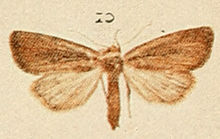Coenobia rufa
| Coenobia rufa | |
|---|---|

| |
| Scientific classification | |
| Kingdom: | |
| Phylum: | |
| Class: | |
| Order: | |
| Family: | |
| Genus: | |
| Species: | C. rufa
|
| Binomial name | |
| Coenobia rufa (Haworth, 1809)
| |
| Synonyms | |
|
Phytometra rufa Haworth, 1809 | |
The Small Rufous (Coenobia rufa) is a moth of the family Noctuidae. It is found in western and central Europe, Scandinavia and the British Isles.[1][2][3]
Description[edit]
The wingspan is 22–25 mm.[2] Forewing uniform rufous, with an obscure dark streak from base along middle of wing; a row of outer dots on veins, sometimes hardly visible; hindwing pale, greyer towards termen; in the ab. lineola Stph the forewing is reddish grey; the veins dotted pale and dark grey; the inner and outer lines shown by rows of dots; in pallescens Tutt the red tinge is wholly absent, the forewing being whitish ochreous.[4] •— Larva whitish, dorsally reddish; a dark lateral line, and minute dark dots on each segment; head and plates shining brown.
The moth flies in July and August. The larvae feed on jointed rush (Juncus articulatus) and other rushes.[5][6] Found in damp swampy places overgrown with rushes; often flying in the afternoon sunshine; the females are rarely taken, resting concealed in the lower parts of the rush clumps.
References[edit]
- ^ Markku Savela. "Coenobia rufa". funet.fi. Retrieved 7 January 2013.
- ^ a b Bert Gustafsson (10 November 2009). "Coenobia rufa". Naturhistoriska riksmuseet. Retrieved 7 January 2013.
- ^ Mike Wall. "2379 Small Rufous (Coenobia rufa)". Hants Moths. Retrieved 7 January 2013.
- ^ Seitz, A. Ed., 1914 Die Großschmetterlinge der Erde, Verlag Alfred Kernen, Stuttgart Band 3: Abt. 1, Die Großschmetterlinge des palaearktischen Faunengebietes, Die palaearktischen eulenartigen Nachtfalter, 1914
- ^ Wikisource:The Moths of the British Isles/Chapter 15#299
- ^ "Robinson, G. S., P. R. Ackery, I. J. Kitching, G. W. Beccaloni & L. M. Hernández, 2010. HOSTS - A Database of the World's Lepidopteran Hostplants. Natural History Museum, London".
External links[edit]
